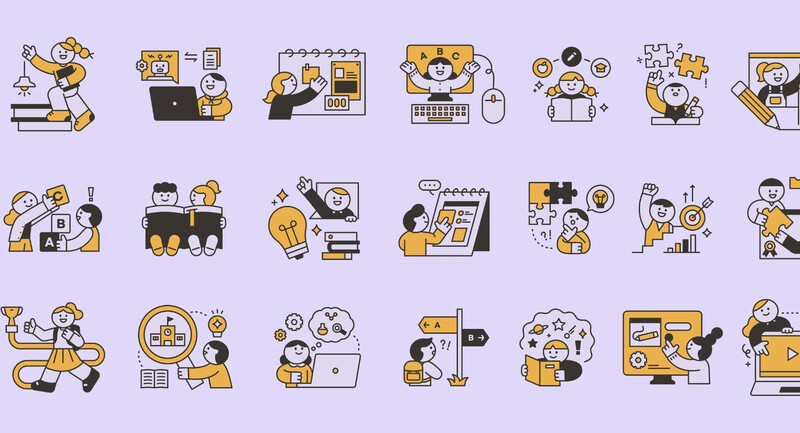In a perfect world, there would be no grades. Instead, there would be feedback to students from teachers and others, coupled with opportunities to use the feedback to improve both performance and understanding.
Is that perfect world here now? Unfortunately, no. Grades of some sort—whether that means proficiency levels, A–F scales, or percentages—are necessary in most school settings for administrative functions that come with doing education at scale.
Of the grading choices, I prefer proficiency levels because they have the best chance of serving as information that can also help students learn. In contrast, the A–F scale and the percentage scale have some specific problems that proficiency levels don't. If you remove the requirement that grades need to support administrative functions like aggregating (calculating class averages), sorting (tracking or placement decisions), and ranking (selecting a valedictorian), however, many other options are available for sharing information with students to help them learn.
Requirements for Going Gradeless
To go gradeless, educators need to do two main things.
Find other ways to do administrative tasks that require aggregating, sorting, and ranking.
Identify the kind of information that can both support and report student learning and make sure all teachers and students know how to do that well.
Assessment to support and report learning without grades will not work seamlessly until we figure out how to reframe the administrative functions that require quantitative grade scales. We need more input from administrators about how to accomplish that. In the meantime, teachers can independently follow strategies to change grading practices.
Support and Report Learning Without Grades
Description (as opposed to common practices of evaluation) supports and reports learning better than grades. Students need to (a) develop a concept of the long-term learning goal and the short-term (lesson-sized) learning target; (b) understand the criteria by which they will know exactly what the target entails and how they are moving toward it; and (c) receive descriptive feedback that will help them get their bearings on the target and criteria, their current place on their learning journey, and what to do next.
To best report learning without the evaluative and sorting/ranking issues surrounding grades, students need to describe (a) what they tried to learn and why, (b) how well they learned it, and (c) how they know (what evidence they have).
As students work toward a learning goal, they develop a clearer idea of what they are trying to learn, informed by applying criteria to their own work. In this formative cycle, feedback is information from any source that helps students get closer to their goal and figure out what they need to do next. In the context of going gradeless, we especially should focus on feedback from teachers. Instead of grading, they could use time more effectively by providing actionable descriptive feedback and giving students in-class, supervised opportunities to use the feedback to reflect on their progress.
It is easy to say that teachers should give better feedback, but not so easy to do. In my experience, increasing teachers' knowledge of feedback concepts and strategies takes professional development, but increasing skills at giving feedback (whether written or oral) only comes with practice. So, there's sometimes a vicious cycle—teachers who feel a need to grade everything may not have the time or the bandwidth to spend practicing high-quality feedback and planning appropriate follow-up. The feedback might remain just as judgmental and evaluative as grades are. High-quality feedback should describe work against criteria students themselves understand and suggest attainable next steps at the appropriate level of challenge.
I have worked with many teachers who have begun the journey toward gradeless assessment. Examples abound of teachers who have realized that the place for feedback is during the learning, that practice work should not be graded, and that effective feedback describes students' understandings and next steps. Teachers who give this kind of feedback learn as much as their students do about how students are thinking, which merges into instructional techniques.
Assessment to Report Learning
The stickier wicket is going gradeless with assessment to report learning. All of the issues involved in instructional feedback are in play–students' understanding of learning goals and criteria, students actually trying to learn, and teachers having the time and skills to craft effective messages about student learning. Descriptions need to be brief but with necessary information, well-written considering learning goals and criteria, evenhanded in tone, and written in language students and parents can understand.
Student-led parent conferences are the most viable solution to being both gradeless and descriptive. Teachers provide statements of learning goals (older students can collaborate as well) and structured class time for students to analyze and organize their work and decide how they will show and tell parents what they have learned. All of this can consolidate learning, giving it instructional as well as assessment value. Two issues to note: Given the intensity of the event, students beyond perhaps kindergarten and 1st grade may only have time to describe a sample of learning outcomes well. A second is that not all students will have parents or guardians who are able to attend the conferences, changing the nature of the reporting for those students.
Narrative reporting by teachers is another great way to communicate with parents in more depth about students' learning. Developing reports (or even effective report card comments) requires the ability to present persuasive evidence from student work to support your point. While narrative reporting is a heavier lift, it can be a great boon to a multiple-measures approach.
Can You Go Gradeless?
The key to gradeless assessment methods is clear learning goals and descriptive (as opposed to evaluative) assessment methods. We can see our way clearly to assessment to support learning using the formative learning cycle and descriptive feedback and follow-up. Promising practices exist for going gradeless for assessment to report learning, but until some administrative problems are solved or reframed, we still need grading scales that can support administrative needs to aggregate information and sort or rank students. I look forward to the perfect world in which we won't have to do much of that. In the meantime, there are gradeless, descriptive assessment methods that should be used much more frequently than they are now as part of school reporting systems.







